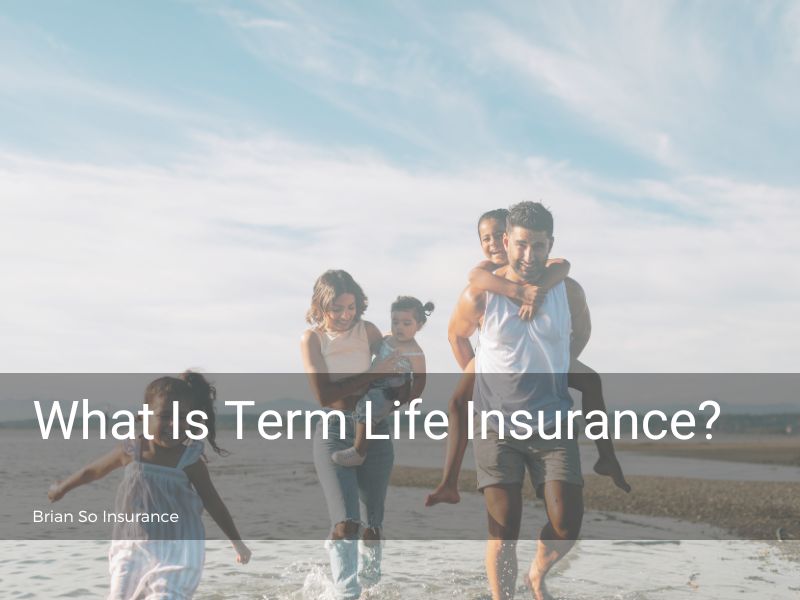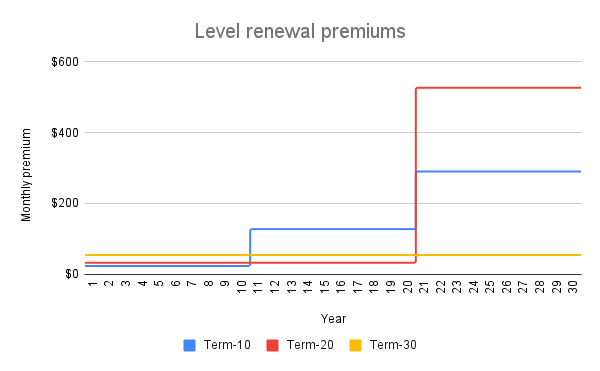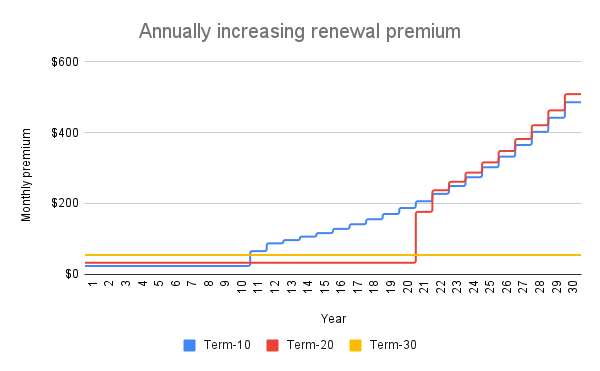Table of contents
Term life insurance is a popular and affordable way to provide financial protection for your loved ones in the event of your passing. It offers a guaranteed death benefit for a specific period, such as 10, 20, or 30 years, helping ensure that your family is financially secure.
Whether you’re looking to replace lost income, pay off debts, or cover future expenses, term life insurance can provide peace of mind during your most important years.
In this guide, we’ll explore how term life insurance works, the different types of policies available, and help you determine which option best fits your needs.
- Key takeaways:
- Term life insurance provides cost-effective coverage to protect your loved ones financially if you pass away during the policy term.
- Term policies typically last 10, 15, 20, 25, or 30 years, offering flexibility based on your needs and financial goals.
- You can tailor term life insurance policies by choosing a coverage amount and term length that fit your specific needs.

What Is Term Life Insurance and How Does It Work?
What is term life insurance coverage?
Term life insurance is a straightforward and affordable type of life insurance that provides financial protection for a specific period, known as the “term.” Common term lengths include 10, 15, 20, 25, or 30 years, but other durations between 5 and 50 years are also available, depending on the insurance company. If the insured person passes away during the term, the insurance company pays a tax-free lump sum death benefit to the designated beneficiaries.
Unlike permanent life insurance, term insurance is life insurance in its purest form. Therefore, it does not have a savings component. This simplicity makes it an appealing choice for individuals and families looking for affordable coverage to protect their dependents against temporary financial risks, such as:
- Replacing lost income
- Paying off a mortgage or debts
- Covering children’s education expenses
- Paying for final expenses like taxes and funeral costs
How does term life insurance work?
A term life insurance policy involves a contract between you (the owner) and the insurance company, where:
- You choose a term and coverage amount: Select the duration of the policy based on your needs (e.g., the length of a mortgage, until children become financially independent, or until your retirement age). The coverage amount should align with the financial impact your loved ones would face in your absence, typically factoring in income replacement and the repayment of outstanding debts.
- You pay premiums: Regular premiums are paid (monthly or annually) for the length of the term. Term life premiums are based on factors like age, gender, smoking status, health, and the coverage amount.
- The insurer provides coverage: If you pass away while the policy is active, the insurance company pays your beneficiaries the death benefit tax-free. As long as you continue to pay premiums, the insurance company can’t change your coverage or cancel your policy. This is known as a non-cancellable policy.
What happens at the end of the term?
If you survive until the end of the term, you have three options to deal with the policy:
- Renewal: Most policies allow you to renew the coverage after the term ends, although premiums increase with age. In some cases, the renewal rates are ten times more than the initial term, so this option is rarely used.
- Conversion: Most term policies offer the option to convert to a permanent policy (like universal or whole life insurance) without requiring a medical exam. This may be beneficial if you need permanent insurance but won’t qualify due to health or lifestyle issues.
- Lapse: If you don’t renew or convert, the coverage ends, and no further premiums or benefits apply. Since most people’s life expectancy exceeds the term length, most policies ultimately lapse without a payout.
Benefits of term life insurance
Term life insurance offers a range of advantages, making it an appealing choice for many individuals and families seeking affordable and flexible coverage.
1. Affordability
Term life insurance provides substantial coverage at a lower cost compared to permanent life insurance. This makes it an excellent option for breadwinners on a budget looking to protect their families. You can even bundle the coverage with your partner or spouse for additional savings.
2. Predictable cost
With fixed premiums for the entire term, you can enjoy predictable costs, making it easier to budget for long-term financial planning.
3. Tax-free payment
The death benefit paid to beneficiaries is tax-free, ensuring that your loved ones receive the full insurance payout without additional financial burdens.
4. Customizable coverage
Term life insurance policies can be tailored to meet your unique needs. You can select a term length (e.g., 10, 20, or 30 years) and a benefit amount that aligns with your financial goals. Additionally, you can enhance your policy with riders like accidental death or disability waiver of premium for added protection.
5. Flexibility
Term life insurance adapts to your changing circumstances. You can adjust coverage as your needs evolve, or cancel the policy without penalties if it’s no longer required. Most term life policies include the option to convert to a permanent insurance policy, like universal life or whole life insurance, without a medical exam required. This is especially valuable if you later decide you need lifetime coverage.
By combining affordability, flexibility, and valuable features, term life insurance provides a practical and accessible solution for securing your family’s financial future.
Types Of Term Life Insurance
Term life insurance comes in several forms, each tailored to meet different financial needs and goals. Understanding the options can help you choose the best fit for your situation.
Renewable term life insurance
Renewable term life insurance policies allow you to renew coverage at the policy anniversary after the initial term ends, without providing evidence of good health.
The premium increases with each renewal, reflecting your age at the time of renewal. Some policies renew annually with increasing premiums. Others allow renewal at a level premium for another period with the same term length, providing predictable costs for an extended duration. However, it should be noted that each subsequent term is substantially more expensive than the initial term.
Here are two graphs showing the premiums for the initial and renewal terms for various term lengths. The rates illustrated are for a 35-year-old male non-smoker at standard rates purchasing $500,000 of death benefit.


Level term insurance
Level term insurance provides a fixed coverage amount that remains unchanged throughout the policy term. As the most common type of term coverage, it’s ideal for those seeking stable, predictable coverage for a specific period. For instance, individuals looking to ensure their loved ones have income replacement until retirement often find level term insurance to be a suitable choice.
Decreasing term insurance
The coverage amount on a decreasing term insurance policy reduces over time, often aligning with a declining financial obligation like a mortgage or loan. Despite the gradually lowering coverage, the monthly premium remains level throughout the entire term, although it costs less than a level term policy. Decreasing term insurance is most suitable for those looking to protect specific debts rather than providing long-term income replacement.
Convertible term insurance
Convertible term insurance allows you to convert a term policy into a permanent life policy (e.g., universal or whole life insurance) without undergoing medical underwriting. Most term life insurance policies in Canada include a conversion option, providing flexibility for changing needs. It’s an ideal choice for individuals who anticipate needing lifetime coverage or those who want to lock in coverage before potential health changes.
Yearly renewable term (YRT) insurance
A yearly renewable term policy provides one-year coverage that can be renewed annually without requiring medical underwriting. While premiums are determined upfront, they increase each year as you age. In Canada, YRT insurance is rarely available as a standalone product but may be included as a feature in universal life insurance policies. It is best suited for short-term needs where keeping initial costs low is a priority.
Traditionally or fully underwritten term life insurance
Traditionally or fully underwritten term coverage is the most common type of term life insurance. The underwriting process involves a detailed questionnaire about your health, lifestyle, and family history.
Additionally, you may need to undergo a medical exam, including blood and urine tests, blood pressure readings, and height and weight measurements. If you have existing medical conditions, the insurance company may also request reports from your family doctor or a specialist.
After reviewing this information, the insurer assigns you a rating based on your individual circumstances: standard for average health, a higher cost if your health is below average, a lower preferred premium for better-than-average health, or a decision to postpone or decline coverage. This thorough process ensures accurate pricing but typically takes anywhere from a week to over a month from application to policy issuance.
Simplified or guaranteed issue term life insurance
Simplified issue or guaranteed issue term insurance, also known as no medical life insurance, is designed for those seeking quick and hassle-free coverage. These policies streamline the underwriting process, allowing you to bypass medical exams and doctor’s reports, which can significantly delay traditional underwriting. As a result, you can secure coverage in just a few days.
However, because the insurer has less information about your health and lifestyle, the premiums are higher than traditionally underwritten policies, and the coverage amount is often limited.
Despite these drawbacks, it’s an excellent option for individuals with medical conditions or those who want to avoid the lengthy and complex underwriting process.
Term Life Insurance vs. Permanent Life Insurance
The choice between term and permanent life insurance depends largely on your individual needs and financial goals. Both types of policies offer valuable protection, but they serve different purposes.
Term coverage is ideal for those who need substantial coverage at an affordable price. Most people who require a large amount of insurance for a relatively low cost turn to a term policy. Because it doesn’t include a cash value component, term life insurance premiums are much lower compared to permanent life insurance.
On the other hand, permanent life insurance policies provide lifetime coverage and guarantee a payout, as long as premiums are paid. Permanent coverage is often used in estate planning to cover costs such as charitable donations, funeral expenses, probate fees, and final tax obligations.
Permanent life insurance policies, like whole life or universal life, also have a savings component. This allows you to accumulate cash value over time, which can be accessed while you’re alive. However, this added benefit comes with higher premiums, making it less affordable except for high-income earners and high-net-worth individuals.
Ultimately, the decision between term and permanent coverage comes down to what you need most—affordability and temporary coverage or lifelong protection with the added benefit of a cash value. The choice should align with your financial goals, current needs, and long-term plans.
Frequently Asked Questions
What is term life insurance?
Term life insurance is a cost-effective option that helps protect your family’s financial well-being if you pass away. It offers coverage for a fixed term, such as 10, 20, or 30 years, during which the premiums and death benefits are guaranteed.
How does term life insurance work?
After you buy a term life insurance policy from an insurance company and pay the premiums, your beneficiaries will receive a death benefit payout if you pass away during the term.
What happens after your term ends?
Most term life insurance coverage in Canada is renewable, meaning you can extend coverage after the term ends. However, premiums will be significantly higher due to your increased age.
What are the disadvantages of term life insurance?
A downside of a term life insurance policy is that you may outlive the term, meaning the policy ends without a payout. Any premiums paid are non-refundable and lost.
How much does term life insurance cost?
Term life insurance rates depend on factors like age, gender, smoking status, health, and lifestyle. The term length and coverage amount also play a significant role.
What is the difference between term life insurance and permanent life insurance?
Term insurance coverage is solely for protection, while a permanent plan offers additional benefits like estate planning, covering final expenses, and serving as a tax-sheltered savings tool.
Can you cash out a term life insurance policy?
No, term life insurance has no cash benefit. You won’t receive money if you cancel the policy, nor can you borrow against it since it doesn’t build cash value.
Ready For A Term Life Insurance Quote?
Term life insurance is a straightforward and affordable way to protect your loved ones financially, providing peace of mind and security for the future. At Brian So Insurance, we’re here to make the process easy and stress-free. From assessing your needs to choosing the right term length and coverage amount, guiding you through the application and underwriting stages, and ensuring your policy is issued smoothly, we support you every step of the way.
Our commitment doesn’t end there—we provide ongoing service to ensure your policy continues to meet your needs as your circumstances evolve. Additionally, we can help you stay fully protected with options for disability insurance, critical illness insurance, and health and dental insurance.
Contact us today for a free, no-obligation consultation. Email us at info@briansoinsurance.com, call 604-928-1628, or use the form below to get a quick quote. Let us help you secure the coverage you need to protect against life’s uncertainties.
Get Your Term Life Insurance Quote Now
While we make every effort to keep our site updated, please be aware that timely information on this page, such as quote estimates, or pertinent details about companies, may only be accurate as of its last edit day. Brian So Insurance and its representatives do not give legal or tax advice. Please consult your own legal or tax adviser. This post is a brief summary for indicative purposes only. It does not include all terms, conditions, limitations, exclusions, and other provisions of the policies described, some of which may be material to the policy selection. Please refer to the actual policy documents for complete details which can be provided upon request. In case of any discrepancy, the language in the actual policy documents will prevail. A.M. Best financial strength ratings displayed are not a warranty of a company’s financial strength and ability to meet its obligations to policyholders.

